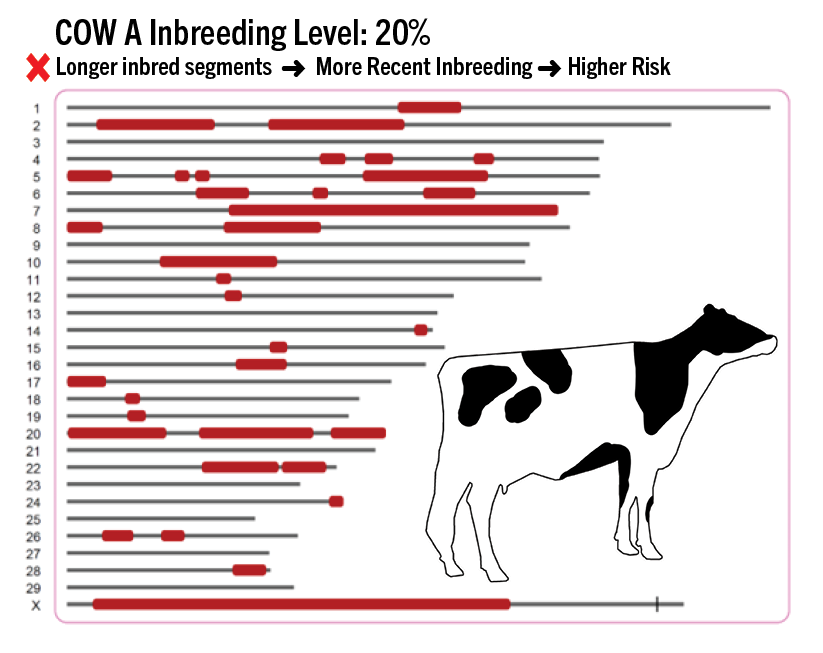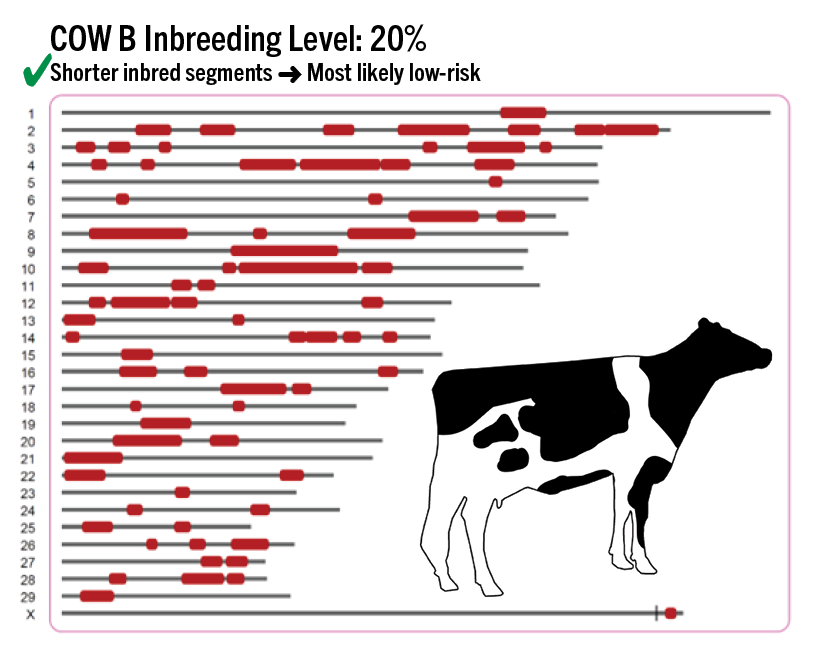What are high- and low-risk inbreeding?
High-risk inbreeding refers to the type of inbreeding that has higher likelihood of carrying deleterious recessive alleles (mutations). Inbreeding arising from recent common ancestors is usually considered high-risk, and low-risk inbreeding is ancient
inbreeding arising from distant common ancestors.
Short ROH segments are associated with ancient inbreeding. It usually indicates the chromosome has experienced multiple crossover events over multiple generations and there has been ample opportunity for purging of deleterious alleles. These short ROH
segments are considered low-risk because they have survived many rounds of selection and continue to show up in high performing animals. Alternatively, long ROH segments have not been split apart by crossover events because they likely haven’t
existed for multiple generations. These long ROH segments are associated with recent inbreeding. They are considered high-risk because deleterious recessive alleles haven’t been exposed and selected against so are more likely to be hiding in these segments.
Low-risk inbreeding is usually stretched over shorter ROH segments (i.e. ancient inbreeding) while the high-risk inbreeding is stretched over longer ROH segments (i.e. recent inbreeding).
To understand this concept better let’s consider ROH-based inbreeding profiles of two cows with the same inbreeding level. Reference the ROH reports below as examples.
Inbreeding of cow A and cow B is 20%. Cow A, on average, has longer ROH segments and therefore carries more recent inbreeding which is considered to be higher risk. But cow B has many shorter ROH segments and therefore a good portion of its inbreeding is most likely low-risk inbreeding.
If, for cows A and B, the short homozygote segments are removed, then cow A would have higher inbreeding than cow B. So, it is essential to consider ROH profile when interpreting the inbreeding.


How can inbreeding information be used in mating decisions?
In mating recommendations, our objective is to control relationships between parents. Note that inbreeding of the sire and the dam is not as important as the relationship between them. This is because progeny inbreeding is determined by the relationship
between parents. Half of the relationship between the sire and the dam is inbreeding of the progeny.
The relationship can be categorized into low- and high-risk relationships like ROH-based inbreeding. That means parents with longer shared chromosomal segments (originated from recent common ancestors) are more likely to produce progeny with longer ROH which carries higher risk inbreeding. Therefore, by putting more weight on avoiding high-risk relationships in the mating program we can penalize less for low-risk inbreeding.
In herds that don’t leverage genomic testing, sire rotation can be an effective strategy if applied correctly. Use of different sires each year reduces the probability of having recent common ancestors in the pedigree and therefore reduces
high-risk inbreeding.
Select Sires uses a two-tier approach to control inbreeding in herds and in the population. The main and critical tier is to develop a diverse lineup of sires. Select Sires is well known for its sire diversity and elite genetics, which is achieved by striking the right balance between selection pressure and diversity. The second tier is the algorithm used for determining mating recommendations. Select Sires uses well-designed tools including Select Mating Service® (SMS®), and World Wide Mating Service (WMS) in international markets, to manage herds’ profitability and inbreeding. These tools use genomic/traditional PTAs to maximize the genetic level of herds according to their customized goals. At the same time, these tools emphasize sire diversification, avoiding closely related parents with high-risk relationships and prevent mating of parents with known genetic conditions such as cholesterol deficiency, muscle weakness and more.
Take home message:
One misconception within mating decisions stems from a need to avoid using inbred parents. Even though inbreeding of an individual parent has an impact on the fitness of that parent, the key measure to consider in mating decisions is actually
the relationship between the two candidate parents. The best strategy to manage inbreeding at the herd level is to use a diverse group of sires along with a mating program, preferably genomic mating that avoids recent or high-risk relationships,
while maximizing genetic progress.